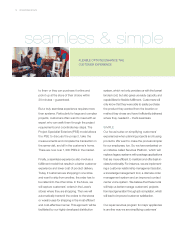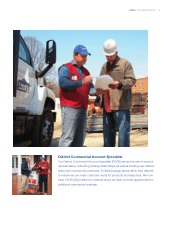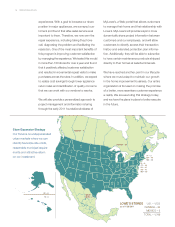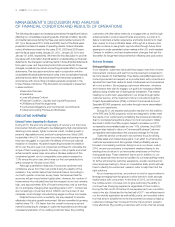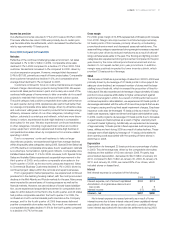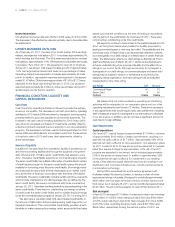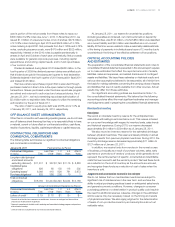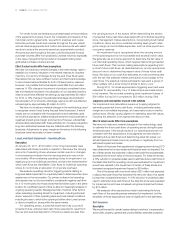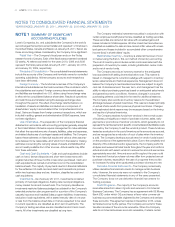Lowe's 2010 Annual Report Download - page 28
Download and view the complete annual report
Please find page 28 of the 2010 Lowe's annual report below. You can navigate through the pages in the report by either clicking on the pages listed below, or by using the keyword search tool below to find specific information within the annual report.24 LOWE’S 2010 ANNUAL REPORT
For vendor funds, we develop accrual rates based on the provisions
oftheagreementsinplace.Duetothecomplexityanddiversityofthe
individual vendor agreements, we perform analyses and review
historical purchase trends and volumes throughout the year, adjust
accrual rates as appropriate and confirm actual amounts with select
vendors to ensure the amounts earned are appropriately recorded.
Amounts accrued throughout the year could be impacted if actual
purchase volumes differ from projected purchase volumes, especially
in the case of programs that provide for increased funding when
graduated purchase volumes are met.
Effect if actual results differ from assumptions
We have not made any material changes in the methodology used to
establish our inventory valuation or the related reserves for obsolete
inventory or inventory shrinkage during the past three fiscal years.
We believe that we have sufficient current and historical knowledge
to record reasonable estimates for both of these inventory reserves.
However, it is possible that actual results could differ from recorded
reserves. A 10% change in the amount of products considered obso-
lete and therefore included in the calculation of our obsolete inventory
reservewouldhaveaffectednetearningsbyapproximately$2million
for 2010. A 10% change in the estimated shrinkage rate included in
the calculation of our inventory shrinkage reserve would have affected
netearningsbyapproximately$8millionfor2010.
We have not made any material changes in the methodology used
to recognize vendor funds during the past three fiscal years. If actual
results are not consistent with the assumptions and estimates used,
wecouldbeexposedtoadditionaladjustmentsthatcouldpositivelyor
negatively impact gross margin and inventory. However, substantially
all receivables associated with these activities do not require subjective
long-term estimates because they are collected within the following
fiscal year. Adjustments to gross margin and inventory in the following
fiscal year have historically not been material.
Long-Lived Asset Impairment – Operating Stores
Description
AtJanuary28,2011,$19.0billionofourlong-livedassetswere
associated with stores currently in operation. We review the carrying
amounts of operating stores whenever certain events or changes
in circumstances indicate that the carrying amounts may not be
recoverable. When evaluating operating stores for impairment, our
asset group is at an individual store level, as that is the lowest level for
whichcashowsareidentiable.Cashowsforindividualoperating
stores do not include an allocation of corporate overhead.
We evaluate operating stores for triggering events relating to
long-lived asset impairment on a quarterly basis to determine when store
assets may not be recoverable. Our primary indicator that operating
storeassetsmaynotberecoverableisconsistentlynegativecashow
for a 12-month period for those stores that have been open in the same
location for a sufficient period of time to allow for meaningful analysis of
ongoing operating results. Management also monitors other factors
when evaluating operating stores for impairment, including individual
stores’executionoftheiroperatingplansandlocalmarketconditions,
including incursion, which is the opening of either other Lowe’s stores
or direct competitors’ stores within the same market.
For operating stores, a potential impairment has occurred if
projectedfutureundiscountedcashowsexpectedtoresultfrom
the use and eventual disposition of the store assets are less than
the carrying amount of the assets. When determining the stream
ofprojectedfuturecashowsassociatedwithanindividualoperating
store, management makes assumptions, incorporating local market
conditions, about key store variables including sales growth rates,
grossmarginandcontrollableexpenses,suchasstorepayrolland
occupancyexpense.
An impairment loss is recognized when the carrying amount
oftheoperatingstoreisnotrecoverableandexceedsitsfairvalue.
We generally use an income approach to determine the fair value of
our individual operating stores, which requires discounting projected
futurecashows.Thisinvolvesmakingassumptionsregardingboth
astore’sfuturecashows,asdescribedabove,andanappropriate
discount rate to determine the present value of those future cash
ows.Wediscountourcashowestimatesataratecommensurate
with the risk that selected market participants would assign to the
cashows.Theselectedmarketparticipantsrepresentagroupof
other retailers with a store footprint similar in size to ours.
During2010,15storesexperiencedatriggeringeventandwere
evaluated for recoverability. Four of these stores were determined
to be impaired. We recorded operating store impairment losses of
$36millionduring2010comparedto$53millionduring2009.
Judgments and uncertainties involved in the estimate
Our impairment loss calculations require us to apply judgment in
estimatingexpectedfuturecashows,includingestimatedsales,
marginandcontrollableexpenses,andassumptionsaboutmarket
performance. We also apply judgment in estimating asset fair values,
including the selection of an appropriate discount rate.
Effect if actual results differ from assumptions
We have not made any material changes in the methodology used
toestimatethefuturecashowsofoperatingstoresduringthepast
three fiscal years. If the actual results of our operating stores are not
consistent with the assumptions and judgments we have made in
estimatingfuturecashowsanddeterminingassetfairvalues,our
actual impairment losses could vary positively or negatively from our
estimated impairment losses.
Elevenofthestoresthatexperiencedatriggeringeventduring2010
were determined to be recoverable and therefore were not impaired. For
tenofthesestorestheexpectedundiscountedcashowssubstantially
exceededthenetbookvalueofthestoreassets.Forthesetenstores,
a10%reductioninprojectedsalesusedtoestimatefuturecashowsat
the latest date that the operating stores were evaluated for impairment
would have resulted in the impairment of certain of these stores and
increasedrecognizedimpairmentlossesby$39million.
Oneofthestoreswithanetbookvalueof$21millionhadexpected
undiscountedcashowsthatexceededthenetbookvalueofitsassets
by less than a substantial amount. A 10% reduction in projected sales
usedtoestimatefuturecashowsatthedatethisstorewasevaluated
for impairment would have increased recognized impairment losses
by$15million.
We analyzed other assumptions made in estimating the future
cashowsoftheoperatingstoresevaluatedforimpairment,butthe
sensitivity of those assumptions was not significant to the estimates.
Self-Insurance
Description
We are self-insured for certain losses relating to workers’ compensation;
automobile;property;generalandproductliability;extendedprotection


